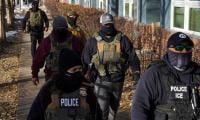Resolving the Afghan conundrum
The manner in which the Taliban are making advances in Afghanistan has resulted in heightening diplomatic efforts to find some kind of a negotiated settlement for a peaceful transfer of power to take place.
There is now a consensus within the intelligence community that the Afghan government will not be able to withstand the Taliban offensive beyond six months despite enjoying numerical superiority and being better armed. The instances of desertions in the Afghan National Army are increasing by the day, a major sign of the meltdown of the Afghan state in its present form.
The Taliban’s claim of having occupied 85 percent of the Afghan territory may have been greatly exaggerated as part of a propaganda blitz but they definitely have a distinct advantage on the battlefield.
According to independent observers, the Taliban have taken control of many key districts without much fight. They seem to be on the march in the northwest, with seven international border crossings under their command. After the pullout of the US and Nato forces the Taliban sense that historic victory is in sight, a prospect that has emboldened them to behave as a legitimate claimant of the power in Kabul.
The regional push for peace and reconciliation in Afghanistan is driven by fear of potential spillover of violence into the neighbouring countries. Several peace tracks are being followed with nothing tangible to show so far in terms of breaking the stalemate between the Taliban and the Ghani-led government.
The Doha peace talks are not proceeding even at a proverbial snail’s pace. The chasm of distrust between the Ghani government and the Taliban has only been widening. The snub of being cut off from the Doha dialogue inflicted on the Afghan government has divested it of the ability to appraise the situation in light of prevailing realities and try to chart a realistic way forward to avert the bloody war ahead.
The Ghani administration has either acted like an ostrich unable to see the writing on the wall or found it convenient to scapegoat Pakistan for the collective failures in Afghanistan. The Taliban, on the other hand, think that they have no incentive to enter into a dialogue with the Afghan stakeholders, principally the Ghani government.
In their calculations, the Trump administration’s direct engagement with them meant that they are a legitimate stakeholder in the Afghan imbroglio and their unprecedented victories on the battlefield have given them an upper hand. Hence, they have every reason to dictate the terms of engagement not just with other Afghan parties but also with the regional countries.
In order to assuage the increasing global fears about how they will operate as rulers, the Taliban have employed a clever strategy. In their interactions with the regional countries, they have assured that they have learnt their lessons from the past and will be inclusive in their approach and beholden to the international concerns about minorities and women rights. They have also vowed to not allow the Afghan soil to be used for the perpetration of terrorism against any country. These claims have yet to be tested on the touchstone of reality.
At the same time, local Taliban commanders have dropped hints that betray the fact that the militia’s worldview remains regressive, and that there is no fundamental change in how they intend to govern the country. The jury is still out as to the real intentions of the Taliban.
As the battle for Kabul intensifies, the critical headway that the Taliban are making militarily has been followed by the emergence of pro-Taliban voices across various media platforms. The peddling of such narrative is geared towards creating a ‘feel-good’ factor to encourage greater legitimacy for the group and assimilation of its worldview into the mainstream.
The second track refers to the Iran-supported peace talks between the Afghan government and the Taliban. Chaired by the Iranian foreign minister, the talks between Yunus Qanuni, former vice-president and the Taliban representatives have indicated the willingness of both the parties to keep the door of dialogue open. Of late, the Taliban have reached out to Tehran to forge a working relationship based on a greater understanding of each other’s concerns.
The third important peace track consists of the joint Russian and Chinese push for peace and reconciliation. The recently concluded meeting of the SCO Council of Foreign Ministers offered to ‘facilitate, not mediate’ in the resolution of the Afghan conflict, a key development considering positive Chinese influence over the warring parties in Afghanistan.
As articulated by Chinese Foreign Minister Wang Yi, China put three key priorities on the table: first, Beijing is ready to facilitate any ‘real’ peace and reconciliation effort that seeks a durable political solution and prevents an all-out civil war. Second, China wants the Taliban to not allow the Afghan soil to be used by any terror outfits such as Al-Qaeda, ISIS-Khorsan chapter, and Eastern Turkestan Islamic Movement (ETIM. Three, the Taliban must demonstrate that they have sought a complete break with these organizations.
While making these demands, Beijing is careful in the choice of words and does not wish to be seen as interfering in a sovereign country’s affairs.
Russia is aware of the serious threats that the prolonged conflict in Afghanistan can pose to the Central Asian Republics (CARs), thus exposing its backyard to real dangers. Moscow has proposed the establishment of a ‘provisional coalition government’ consisting of the Taliban and Kabul reps for 2-3 years to allow for the space within which to find a more permanent and agreeable solution to the Afghan imbroglio.
Another forum that brings all the regional stakeholders on a single platform is the Extended Troika that includes China, Russia, Pakistan and the US. A major advantage of this grouping is the mutuality of interests of the member-countries that otherwise seem to be locked in a fierce competition and are resultantly pursuing divergent and often clashing interests.
The Extended Troika is in a far better position to pool its economic, diplomatic and political resources to persuade the Afghan parties to agree to some kind of power-sharing formula.
In a recent development, Pakistan, Afghanistan, Uzbekistan and the United States have joined hands to set up a new forum to ‘support peace and stability in Afghanistan’ as part of regional trade and economic connectivity.
The international conference on ‘Central and South Asian Regional Connectivity: Challenges and Opportunities’, held in Tashkent, which was also addressed by PM Imran Khan, was a site for the exchange of criticism, as discussions on deteriorating situation in Afghanistan were the highlight of the proceedings.
In order to boost the regional and international efforts for peace building in Afghanistan, Pakistan had also organized a conference, which for now stands postponed. The key Afghan leaders, except the Taliban, have been invited to the moot to deliberate on the current security situation in the war-battered country and propose solutions to inject meaning and depth to the ongoing peace efforts.
Going by the hectic diplomatic activity, it appears that Afghanistan has clearly assumed regional priority. However, efforts being made in silos need to be merged to allow for a consensus-based peace formula to be presented to all the Afghan parties.
This regional solution must be packaged in a set of options with a clear statement on the consequences for the choices made. The window for peace is closing fast as the escalating violence is likely to set the terms of engagement. Any further delay in launching a final regional peace initiative will lead to serious ramifications for peace and stability not just for Afghanistan but also the wider region.
Email: amanatchpk@gmail.com
Twitter: @Amanat222
The writer, a Chevening scholar, studied International Journalism at the University of Sussex.
-
 Jennifer Aniston, Jim Curtis Face One Major Hurdle In Their Union
Jennifer Aniston, Jim Curtis Face One Major Hurdle In Their Union -
 Restaurant Workers Detained After ICE Agents Dine At Minnesota Eatery
Restaurant Workers Detained After ICE Agents Dine At Minnesota Eatery -
 Kate Middleton Reveals Sport She Would Not Play With Prince George
Kate Middleton Reveals Sport She Would Not Play With Prince George -
 First Poll Since King Charles' Action Against Andrew Reveals Royal Family's Public Standing
First Poll Since King Charles' Action Against Andrew Reveals Royal Family's Public Standing -
 Blake Lively Strengthens Legal Team Ahead Of Justin Baldoni Trial
Blake Lively Strengthens Legal Team Ahead Of Justin Baldoni Trial -
 'Back To School!': Palace Shares Details Of Princess Anne's Latest Engagements
'Back To School!': Palace Shares Details Of Princess Anne's Latest Engagements -
 Paul Mescal Clarifies Acting Break Comment As He Teases Paul McCartney Role
Paul Mescal Clarifies Acting Break Comment As He Teases Paul McCartney Role -
 Kate Middleton's Unexpected Style Of Arrival At Solo Outing Goes Viral
Kate Middleton's Unexpected Style Of Arrival At Solo Outing Goes Viral -
 Why ‘X’ Is Down? Thousands Report Twitter Outage: Here’s What You Can Do
Why ‘X’ Is Down? Thousands Report Twitter Outage: Here’s What You Can Do -
 Florida Man Held After Alleged Nail-scattering On Busy Intersections
Florida Man Held After Alleged Nail-scattering On Busy Intersections -
 Valeria Nicov: Sean Penn's Athletic Girlfriend Raises Eyebrows With Latest Photos
Valeria Nicov: Sean Penn's Athletic Girlfriend Raises Eyebrows With Latest Photos -
 Sharon Stone Lashes Out At Fellow Award Show Attendees After Stealing Accusations
Sharon Stone Lashes Out At Fellow Award Show Attendees After Stealing Accusations -
 Gwyneth Paltrow Reveals Real Reason She Said Yes To 'Marty Supreme'
Gwyneth Paltrow Reveals Real Reason She Said Yes To 'Marty Supreme' -
 King Charles Says He And Queen Camilla Stand With People Of Ukraine
King Charles Says He And Queen Camilla Stand With People Of Ukraine -
 Ben Affleck Argues In Favour Of His Shirtless Scene In 'The Rip'
Ben Affleck Argues In Favour Of His Shirtless Scene In 'The Rip' -
 Mississippi Postal Worker Arrested After Complaints Of Marijuana Odour In Letters
Mississippi Postal Worker Arrested After Complaints Of Marijuana Odour In Letters



